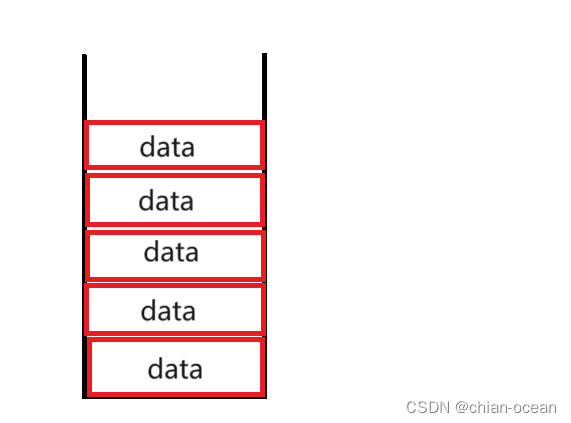Toc
欢迎光临我的Blog,喜欢就点歌关注吧♥
前面介绍了顺序表、单链表、双向循环链表,基本上已经结束了链表的讲解,今天谈一下栈、队列。可以简单的说是前面学习的一特殊化实现,但是总体是相似的。
前言
栈是一种特殊的线性表,它只允许在一端进行插入和删除操作。这一端被称为栈顶,另一端被称为栈底。栈的特点是后进先出(LIFO),即最后进入的元素最先被移除。
队列是另一种特殊的线性表,它允许在一端进行插入操作,在另一端进行删除操作。插入操作的一端称为队尾,删除操作的一端称为队头。队列的特点是先进先出(FIFO),即最先进入的元素最先被移除。
栈和队列有各自的特点,严格讲用顺序表还是链表的实现都可以。但我们根据结构特点选择一个更加适合的结构进行是实现。
一、栈和队列的理解
对于栈的理解:

栈如同这个图一样,要是想拿出数据,必须从上面一个一个往下面拿。这也正是 LIFO 的体现。
对于队列的理解:

队列如同这个图一样,要是想拿出数据,必须前面一个一个往向后面拿。这也正是 FIFO 的体现。
二、栈的实现(顺组表)
2.1 栈的功能
//初始化
void STInit(ST* ps);
//压栈
void STpush(ST* ps, STDataType x);
//删除
void STPop(ST* ps);
//大小
int STSize(ST* ps);
//判空
bool STEmpty(ST* ps);
//出栈
STDataType STTop(ST* ps);
//检查容量
void CheckCapacity(ST* ps);
//销毁
void STDestroy(ST* ps);
2.2 栈结构体的定义及其初始化
结构体的定义
typedef int STDataType;typedef struct stack
{STDataType* a;int top;int capacity;
}ST;
初始化(开辟空间)
void STInit(ST* ps)
{assert(ps);ps->a = (STDataType*)malloc(sizeof(STDataType)*4);if (ps->a == NULL){perror("malloc fail");return;}ps->capacity = 4;ps->top = 0;
}
2.3 压栈(存储数据)
//压栈
void STpush(ST* ps,STDataType x)
{assert(ps);ps->a[ps->top] = x;ps->top++;
}
2,4 删除数据
在这里面删除数据是配合,栈顶出栈。每次拿出一个数据,就要减少一个数据。
void STPop(ST* ps)
{assert(ps);assert(!STEmpty(ps));ps->top--;
}
2.5 计算栈内元个数
//大小
int STSize(ST* ps)
{assert(ps);return ps->top;
}
2.6 判断栈内是否为空
这里运用 bool 类型直接返回,比较方便。
bool STEmpty(ST* ps)
{assert(ps);return ps->top == 0;
}
2.7 出栈
//出栈
STDataType STTop(ST* ps)
{assert(ps);return ps->a[ps->top-1];
}
2.8 增加容量
//检查容量
void CheckCapacity(ST*ps)
{assert(ps);if (ps->top == ps->capacity){ST* tmp = (STDataType*)realloc(ps->a, sizeof(STDataType) * (ps->capacity) * 2);if (tmp == NULL){perror("malloc fail");return;}ps->capacity *= 2;ps->a = tmp;}
}
2.9 销毁栈
//销毁
void STDestroy(ST* ps)
{assert(ps);free(ps->a);ps->a = NULL;ps->capacity = 0;ps->top = 0;
}
三、队列的实现(单链表)
3.1 队列的功能
//初始化
void QueueInit(Queue* ps);
//销毁
void QueueDestroy(Queue* ps);
//入队
void QueuePush(Queue* ps, QDataType x);
//删除
void QueuePop(Queue* ps);
//大小
int QueueSize(Queue* ps);
//判空队
bool QueueEmpty(Queue* ps);
//出队头
QDataType QueueTop(Queue* ps);
//出队尾
QDataType QueueBack(Queue* ps);
3.2 队列的结构体定义以及初始化
结构体定义
定义两个结构体,第一个为存放数据,第二个结构体为两个指针,分别指向头和尾
typedef int QDataType;typedef struct QNode
{struct QNode* next;QDataType data;}QNode;typedef struct Queue
{QNode*head;QNode*tail;int szie;
}Queue;
初始化
//初始化
void QueueInit(Queue* ps)
{assert(ps);ps->head = ps->tail = NULL;ps->szie = 0;}
3.3 队列销毁
//销毁
void QueueDestroy(Queue* ps)
{assert(ps);QNode* cur = ps->head;while (cur){QNode* next = cur->next;free(cur);cur = next;}ps->head = ps->tail = NULL;ps->szie = 0;
}
3.4 入队(插入数据)
//入队
void QueuePush(Queue* ps,QDataType x)
{assert(ps);QNode* newcode = (QNode*)malloc(sizeof(QNode));if (newcode == NULL){perror("malloc fail");return ;}newcode->next = NULL;newcode->data = x;if (ps->head == NULL){ps->head = ps->tail = newcode;}else{ps->tail->next = newcode;ps->tail = newcode;}ps->szie++;}
3.5 删除数据(头删)
//删除
void QueuePop(Queue* ps)
{assert(ps);assert(ps->head != NULL);assert(!QueueEmpty(ps));if (ps->head->next == NULL){free(ps->head);ps->head = ps->tail = NULL;}else{QNode* next = ps->head->next;free(ps->head);ps->head = next;}ps->szie--;
}3.6 计算队列元素个数
//大小
int QueueSize(Queue* ps)
{assert(ps);return ps->szie;
}
3.7 判断是否队列为空
//判空队
bool QueueEmpty(Queue* ps)
{assert(ps);return ps->szie == 0;
}
3.8 出队(头)
//出队头
QDataType QueueTop(Queue* ps)
{assert(ps);assert(!QueueEmpty(ps));return ps->head->data;
}
3.9 出队(尾)
//出队尾
QDataType QueueBack(Queue* ps)
{assert(ps);return ps->tail->data;
}
四、栈和队列的源码
栈
Stack.h
#pragma once#include <stdio.h>
#include <stdlib.h>
#include <assert.h>
#include <stdbool.h>typedef int STDataType;typedef struct stack
{STDataType* a;int top;int capacity;
}ST;//初始化
void STInit(ST* ps);
//压栈
void STpush(ST* ps, STDataType x);
//删除
void STPop(ST* ps);
//大小
int STSize(ST* ps);
//判空
bool STEmpty(ST* ps);
//出栈
STDataType STTop(ST* ps);
//检查容量
void CheckCapacity(ST* ps);
//销毁
void STDestroy(ST* ps);
Stack.c
#define _CRT_SECURE_NO_WARNINGS#include "stack.h"//初始化
void STInit(ST* ps)
{assert(ps);ps->a = (STDataType*)malloc(sizeof(STDataType*)*4);if (ps->a == NULL){perror("malloc fail");return;}ps->capacity = 4;ps->top = 0;
}
//销毁
void STDestroy(ST* ps)
{assert(ps);free(ps->a);ps->a = NULL;ps->capacity = 0;ps->top = 0;
}//检查容量
void CheckCapacity(ST*ps)
{assert(ps);if (ps->top == ps->capacity){ST* tmp = (STDataType*)realloc(ps->a, sizeof(STDataType) * (ps->capacity) * 2);if (tmp == NULL){perror("malloc fail");return;}ps->capacity *= 2;ps->a = tmp;}
}//压栈
void STpush(ST* ps,STDataType x)
{assert(ps);ps->a[ps->top] = x;ps->top++;
}//删除
void STPop(ST* ps)
{assert(ps);assert(!STEmpty(ps));ps->top--;
}//判空
bool STEmpty(ST* ps)
{assert(ps);return ps->top == 0;
}//出栈
STDataType STTop(ST* ps)
{assert(ps);return ps->a[ps->top-1];
}//大小
int STSize(ST* ps)
{assert(ps);return ps->top;
}
test.c
#define _CRT_SECURE_NO_WARNINGS#include "stack.h"void teststack()
{ST st;STInit(&st);STpush(&st, 1);STpush(&st, 2);STpush(&st, 3);STpush(&st, 4);STpush(&st, 5);printf("%d", STSize(&st));printf("\n");while (!STEmpty(&st)){printf("%d ", STTop(&st));STPop(&st);}printf("\n");printf("%d", STSize(&st));STDestroy(&st);}int main()
{teststack();return 0;
}
队列
Queue.h
#pragma once#include <stdio.h>
#include <assert.h>
#include <stdlib.h>
#include <stdbool.h>typedef int QDataType;typedef struct QNode
{struct QNode* next;QDataType data;}QNode;typedef struct Queue
{QNode*head;QNode*tail;int szie;
}Queue;//单链表的实现,FIFO//初始化
void QueueInit(Queue* ps);
//销毁
void QueueDestroy(Queue* ps);
//入队
void QueuePush(Queue* ps, QDataType x);
//删除
void QueuePop(Queue* ps);
//大小
int QueueSize(Queue* ps);
//判空队
bool QueueEmpty(Queue* ps);
//出队头
QDataType QueueTop(Queue* ps);
//出队尾
QDataType QueueBack(Queue* ps);Queue.c
#define _CRT_SECURE_NO_WARNINGS#include "queue.h"//初始化
void QueueInit(Queue* ps)
{assert(ps);ps->head = ps->tail = NULL;ps->szie = 0;}//销毁
void QueueDestroy(Queue* ps)
{assert(ps);QNode* cur = ps->head;while (cur){QNode* next = cur->next;free(cur);cur = next;}ps->head = ps->tail = NULL;ps->szie = 0;
}//入队
void QueuePush(Queue* ps,QDataType x)
{assert(ps);QNode* newcode = (QNode*)malloc(sizeof(QNode));if (newcode == NULL){perror("malloc fail");return ;}newcode->next = NULL;newcode->data = x;if (ps->head == NULL){ps->head = ps->tail = newcode;}else{ps->tail->next = newcode;ps->tail = newcode;}ps->szie++;}//删除
void QueuePop(Queue* ps)
{assert(ps);assert(ps->head != NULL);assert(!QueueEmpty(ps));if (ps->head->next == NULL){free(ps->head);ps->head = ps->tail = NULL;}else{QNode* next = ps->head->next;free(ps->head);ps->head = next;}ps->szie--;
}//大小
int QueueSize(Queue* ps)
{assert(ps);return ps->szie;
}//判空队
bool QueueEmpty(Queue* ps)
{assert(ps);return ps->szie == 0;
}//出队头
QDataType QueueTop(Queue* ps)
{assert(ps);assert(!QueueEmpty(ps));return ps->head->data;
}//出队尾
QDataType QueueBack(Queue* ps)
{assert(ps);return ps->tail->data;
}test.c
#define _CRT_SECURE_NO_WARNINGS#include "queue.h"void testQueue()
{Queue s;QueueInit(&s);QueuePush(&s, 1);QueuePush(&s, 2);QueuePush(&s, 3);QueuePush(&s, 4);//printf("%d ", QueueTop(&s));//QueuePop(&s);//printf("%d ", QueueTop(&s));//QueuePop(&s); //printf("%d ", QueueTop(&s));//QueuePop(&s); //printf("%d ", QueueTop(&s));//QueuePop(&s);//printf("\n");while (!(QueueEmpty(&s))){printf("%d ", QueueTop(&s));QueuePop(&s);}QueueDestroy(&s);}int main()
{testQueue();return 0;
}
】——个人中心页面的实战项目(二))








)


)


)


